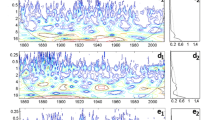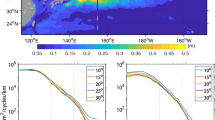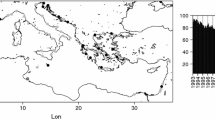Abstract
Monthly wavenumber spectra of sea surface temperatures (SST) have been estimated in two regions near the Kuroshio, in the recirculation and the Kuroshio Extension regions, using the merged SST product to determine the statistical parameter (spatial decorrelation scale) required for optimal interpolation of a high-resolution SST dataset. The two-dimensional wavelet transform was used for analysis. Estimates were made of daily mean and daily minimum SSTs. These do not significantly differ, which suggests that the same covariance matrix can be used for the daily mean and minimum in the merging procedure. The seasonality of wavenumber spectra is significant. There are also large differences between those in the recirculation region and in the Kuroshio Extension region. Therefore, it is recommended that the covariance matrix in the merging process for high-resolution SST dataset be defined as a function of time and space. Improvements of the merging methodology are discussed.
Similar content being viewed by others
References
Antoine, J.-P. and R. Murenzi (1996): Two-dimensional directional wavelets and the scale-angle representation. Signal Processing, 52, 259–281.
Bretherton, F., R. Davis and C. Fandry (1976): A technique for objective analysis and design of oceanographic experiments applied to MODE-73. Deep-Sea Res., 23, 559–582.
Chelton, D. B., R. A. De Szoeke and M. G. Schlax (1998): Geographical variability of the first baroclinic Rossby radius of deformation. {tiJ. Phys. Oceanogr}., 28, 433–460.
Farge, M. (1992): Wavelet transforms and their applications to turbulence. Annu. Rev. Fluid Mech., 24, 395–457.
Gamage, N. and W. Blumen (1993): Comparative analysis of low-level cold fronts: Wavelet, Fourier, and empirical orthogonal function decompositions. Mon. Wea. Rev., 121, 2867–2878.
Gandin, L. S. (1963): Objective Analysis of Meteorological Field. Gidrometeorologicheloe Izdate'stvo, Leningrad, U.S.S.R., 286 pp.
Guan, L. and H. Kawamura (2003): Merging satellite infrared and microwave SSTs-methodlogy and evaluation of the new SST. J. Oceanogr. (submitted).
Hosoda, K. and H. Kawamura (2003): Examination of the merged sea surface temperature using wavelet analysis. J. Oceanogr. (submitted).
Kawai, Y. and H. Kawamura (2002): Evaluation of the diurnal warming of sea surface temperature using satellite-derived meteorogical data. J. Oceanogr., 58, 805–814.
Kuragano, T. and M. Kamachi (2000): Global statistical spacetime scales of oceanic variability estimated from the TOPEX/POSEIDON altimeter data. J. Geophys. Res., 105, 955–974.
Kurasawa, Y., K. Hanawa and Y. Toba (1983): Heat balance of the surface layer of the sea at ocean weather station T. J. Oceanogr. Soc. Japan, 39, 192–202.
Lau, K. M. and H. Weng (1995): Climate signal detection using wavelet transform: how to make a time series sing. Bull. Amer. Meteor. Soc., 76, 2391–2402.
Le Traon, P. Y., M. C. Rouquet and C. Boissier (1990): Spatial scales of mesoscale variability in the North Atlantic as deduced from Geosat data. J. Geophys. Res., 95, 20267–20285.
Le Traon, P. Y., J. Stum, K. Dorandeu, P. Gasper and P. Vincent (1994): Global statistical analysis of TOPEX and POSEIDON data. J. Geophys. Res., 99, 24619–24631.
Le Traon, P. Y., F. Nadal and N. Ducet (1998): An improved mapping method of multi-satellite altimeter data. J. Atmos. Oceanic Technol., 15, 522–534.
Le Traon, P. Y., M. Rienecker, N. R. Smith, P. Bahurel, M. Bell, H. Hurlbert and P. Dandin (2001): Operational oceanography and prediction: A GODAE perspective. Observing the Ocean in the 21st Century, GODAE Project Office, Chapter 6.2, 529–545.
Mariano, A. J. and O. B. Brown (1992): Efficient objective analysis of dynamically heterogeneous and nonstationary fields via the parameter matrix. Deep-Sea Res., 39, 1255–1271.
Meyers, G., H. P. N. Smith and J. Sprintall (1991): Space and time scales for optimal interpolation of temperature-tropical Pacific Ocean. Prog. Oceanogr., 28, 189–218.
Meyers, S. D., B. G. Kelly and J. J. O'Brien (1993): An introduction to wavelet analysis in oceanography and meteorology: With application to the dispersion of Yanai waves. Mon. Wea. Rev., 121, 2858–2866.
Murenzi, R., L. M. Kaplan, F. Mujica and S. Der (1997): Feature extraction in FLIR imagery using the continuous wavelet transform (CWT). First Annual ARL Federated Laboratory Symposium, College Park, Maryland, 14–15.
Reynolds, R. W. and T. M. Smith (1994): Improved global sea surface temperature analysis using optimum interpolation. J. Clim., 7, 929–949.
Sakaida, F., J.-I. Kudoh and H. Kawamura (2000): AHIGHERS-The system to produce the high spatial resolution sea surface temperature maps of the western North Pacific using the AVHRR/NOAA. J. Oceanogr., 56, 707–716.
Salmon, R. (1982): Geostrophic turbulence. p. 30–78. In Topics in Ocean Physics, ed. by A. Osborne and P. Malanotte-Rizzoli, North-Holland.
Shibata, A., A. Imaoka, M. Kachi and H. Murakami (1999): SST observation by TRMM Microwave Imager aboard Tropical Rain Measuring Mission. Umi no Kenkyu, 8, 135–139 (in Japanese).
Tanahashi, S., H. Kawamura, T. Matsuura, T. Takahashi and H. Yusa (2000): Improved estimate of wide-ranging sea surface temperature from GMS S-VISSR data. J. Oceanogr., 56, 345–358.
Torrence, C. and G. Compo (1998): A practical guide to wavelet analysis. Bull. Amer. Meteor. Soc., 79, 61–78.
Vallis, G. K. (1992): Problems and phenomenology in two-dimensional turbulence. In Nonlinear Phenomena in Atmospheric and Oceanic Sciences, ed. by G. F. Carnevale and R. T. Pierre-humbert, Springer-Verlag, Volume 40 of The IMA Volumes in Mathematics and Its Applications, p. 1–25.
Wentz, F. J., C. Gentemann, D. Smith and D. Chelton (2000): Satellite measurements of sea surface temperature through clouds. Science, 288, 847–850.
White, W. B. (1995): Design of global observing system for gyre-scale upper ocean temperature variability. Prog. Oceanogr., 36, 169–217.
White, W. B., G. Meyers and K. Hasunuma (1982): Space/time statistics of short-term climate variability in the western North Pacific. J. Geophys. Res., 87, 1979–1989.
Author information
Authors and Affiliations
Rights and permissions
About this article
Cite this article
Hosoda, K., Kawamura, H. Time-Dependent Spatial Wavenumber Spectra Derived from Merged Sea Surface Temperature Data. Journal of Oceanography 60, 243–251 (2004). https://doi.org/10.1023/B:JOCE.0000038330.80231.28
Issue Date:
DOI: https://doi.org/10.1023/B:JOCE.0000038330.80231.28




